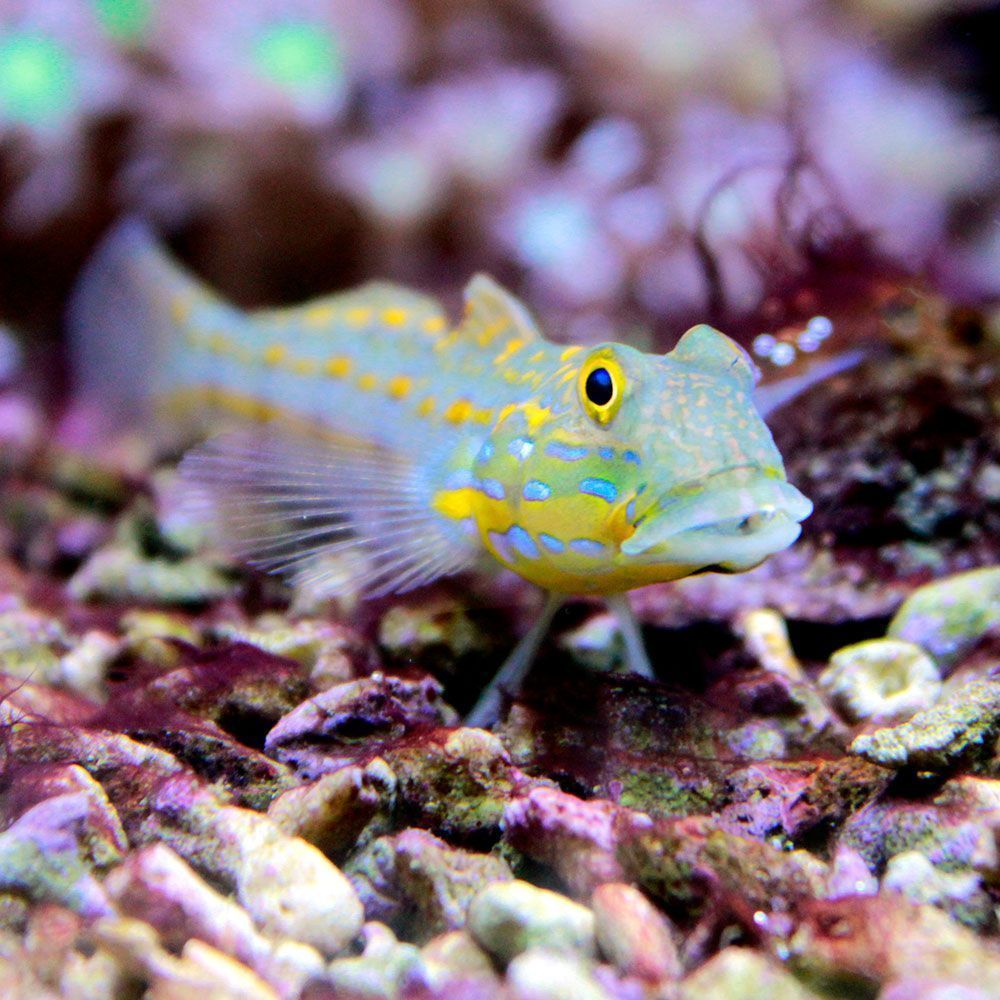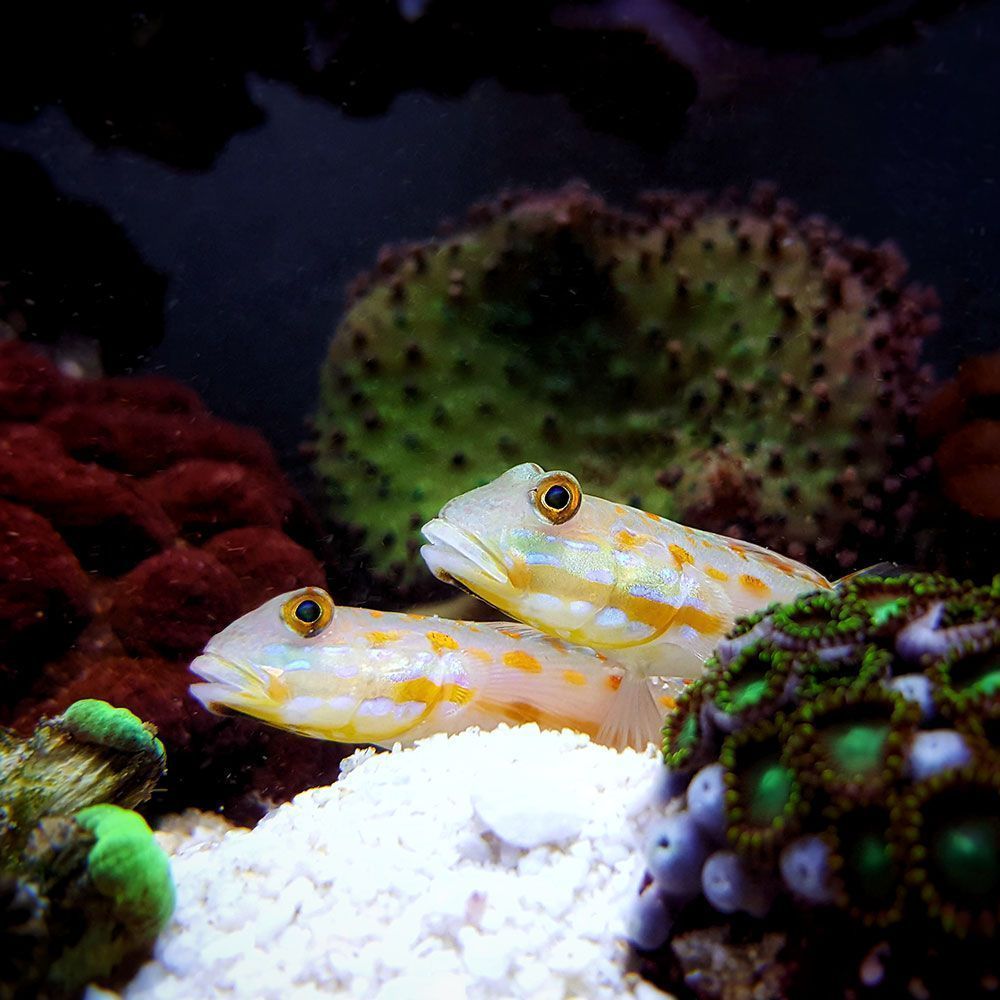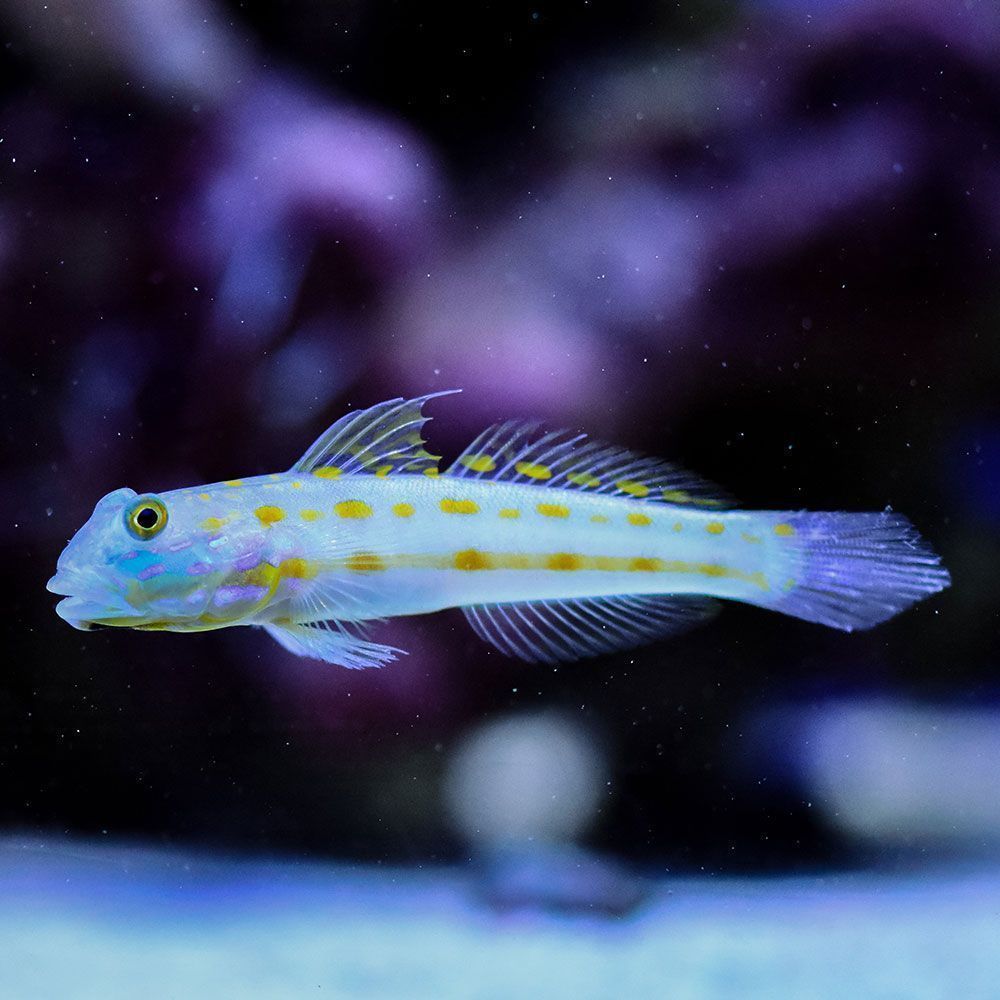The diamond goby is loved for its striking orange spots and glittering blue marks on its face. It’s a hyperactive fish that loves to clean sand and decorations, build burrows, and eat shrimp. The best part? It doesn’t quarrel with tankmates and rarely falls sick.
If you’re ready to welcome this fabulous fish to your saltwater tank, this comprehensive guide is just the thing for you.
What is a Diamond Goby?
Diamond Goby is a saltwater fish that has orange spots and blue marks on its face. It is mainly found in the indo-pacific waters and is popular among fish keepers due to its colors.
| Origin | Indo-Pacific waters |
| Order | Gobiiformes |
| Family | Gobiidae |
| Scientific Name | Valenciennea puellaris |
| Common Names | Maiden goby, diamond watchman goby, orange-dashed goby, orange-spotted sleeper-goby, orange-spotted glider goby, pretty prawn goby |
| IUCN Red List Status | Least Concern |
| Appearance | Pearlescent white body with orange spots and blue spots on the face |
| Size | Up to 20.32 cm (8 in) |
| Lifespan | 3 – 5 years |
| Temperament | Peaceful |
| Reef Safe | Yes |
| Tank Level | Bottom-dwellers but are known to jump |
| Water Temperature | 72-78 °F (22-25 °C) |
| pH Level | 8.1-8.4 |
| Water Hardness | 8-12 dGH |
| Care Level | Easy |
| Minimum Tank Size | 30 gallons |
| Tank Environment | Most comfortable in large live sand beds with many hiding spots |
| Diet | Carnivore |
| Tank Mates | Blennies, cardinalfish, clownfish, damselfish |
What is the Natural Habitat of a Diamond Goby?
Diamond gobies are natives of the Indo-Pacific waters spanning from the Red Sea by the East African coast across the Indian Ocean and further eastward to Samoa. They are also found in New Caledonia and the southern regions of Japan and Australia.
Originating from the tropics, these impulsive cleaners can thrive in waters of varying degrees of saltiness. They prefer warm temperatures and make their homes in shallow waters.
They live in seaward reefs and clear lagoons, hanging out at the bottom of their territories with their mate in tiny burrows they dig under rubble.
With the IUCN Red List indicating Least Concern, these adorable, modest fish have a stable population.
Which family does Diamond Goby belong?
This goby has the scientific name Valenciennea puellaris. It is a member of the Perciformes order and part of the Gobiidae family. This fish is one of fifteen species in the Valenciennea Genus. However, the Gobiidae family is much larger, with over 2000 species in it, making it one of the largest families of fish in fresh and saltwater.
Interestingly, this fabulous fish has some gorgeous cousins, including the immaculate glidergoby (V. immaculata), the bluestreak goby (V. strigata), and the mural goby (V. muralis).
It is called many names, including the orange-spotted sleeper, diamond watchman goby, orange diamond goby, maiden goby, and similar variations. Some stores also name it the pretty prawn goby and the orange square goby.
Fun Fact: A persistent digger, this goby has the habit of knocking over rock formations and décor. Talk about hyper!
How does Diamond Goby look?

What is the Size of a Diamond Goby?
Diamond gobies tend to grow 6 to 7 inches long when mature, but they have been recorded to grow up to 8 inches long. Because of their size and look, they are often mistaken for juvenile common blennies.
You can easily find 2-3 inch-long diamond gobies in stores. Larger, 5-inch gobies are rare finds.
What is the Color of Diamond Goby?
This fish is best known for its diamond-shaped spots on its shiny white body, which are arranged in parallel lines.
It has a series of six vertical intermittently connected orange bars on its body, at the termination of which is the characteristic sizeable orange dot. Below these spots lies one horizontal orange stripe.
What are the Features of Diamond Goby?
Like any goby, the watchman maiden has an elongated body and an unpointed head with high-set eyes.
The fish is called an orange-spotted sleeper for good reason – it has specks of orange throughout its dorsal and caudal fins. Its cheek is dotted with light blue lines extending over its gill plate. The eyes have orange rings around them.
Like all gobies, this fish has no swim bladder, so it swims in bursts.
What is the difference between a male and a female Diamond Goby?
In my experience, there’s no way to distinguish a male diamond goby from a female by looking at their bodies. Some believe the females tend to be larger, while others surmise the males have a larger dorsal fin.
How does Diamond Goby behave?
The orange-spotted goby cleans sand, preventing algae growth and detritus accumulation. Aquarists love having it in their tanks for its ability to polish sand to a bright white.
The sand in your aquarium will never get packed down if it’s home to this sifter, but this comes with a trade-off. Its jerky movements tend to create mounds as it sifts through the sand. So, you can expect your tank’s sand to need flattening out every few days.
These are happy to share a tank with any other species if the tank has many hiding spots. They only get aggressive when encountering another sand sifter except for their mate.
What is the Lifespan of a Diamond Goby?
The lifespan of a diamond goby is usually around 3-5 years. But it can live longer in the proper water with good care.
Did you know? These are total homebodies! They dig several burrows to retreat to and never swim far from their burrows.
How to take care of Diamond Goby?

They are very disease-resistant and easy to care for. They can thrive in an adequately sized tank with other peaceful fish but must be fed twice daily.
What is the Tank Size for Diamond Goby?
A 30-gallon tank is large enough to house one fish of this species. However, it will be healthiest in a 55-gallon tank when it matures.
You must add an additional 15 gallons to your tank for every extra fish you introduce. But if you want two of them, make sure they are a mated pair. Never put this fish in a tank with a sifter from another species. It will trigger quarrels and aggression.
What is the Water Chemistry for Diamond Goby?
These live in salty water, and you can replicate their natural habitat without much hassle.
- pH Levels: 8.1 to 8.4
- Water Temperature: 72 to 78° F (22°C – 25°C)
- Water Hardness: 8 – 12 dGH
- Ammonia: 0 ppm
- Nitrite: 0 ppm
- Nitrate: Below 20 ppm
- Synthetic Salt Level: 26-33 ppt
- Specific Gravity: 1.020 – 1.025
Check the tank’s water quality every few weeks to ensure your goby remains healthy and lives long.
What is the Tank Environment for Diamond Goby?
Ready to give your diamond goby the perfect home? Learn how with our thorough guide for a safe and joyful environment!
Do you need to have Substrate in the Diamond Goby tank?
This fish sifts and obsessively cleans sand in its natural habitat and only feels at home around the sand. So, a live sand bed is a must in any tank housing it. Three to four inches of fine sand will keep it active and happy.
Gravel hurts its gills when it turns the sand, so avoid adding any to your tank.
Which Plants are best for Diamond Goby?
Java moss and java fern are the perfect additions to a live sand tank with a diamond goby. They let through a lot of light and give the tank a striking contrast. Besides, these plants grow in their natural habitat, and these fish often hide behind them.
What Lighting is best for Diamond Goby?
These thrive in moderate to heavy lighting but don’t demand it, so a regular aquarium light will serve them well. You can use a wide spectrum of light to get the most out of this fish’s beautiful bluish spots.
Note that it sometimes likes to get away from the light, making rockwork and plants essential. Without hiding spots, it will get stressed, increasing the odds of illness and early death.
What is the Décor for Diamond Goby?
This beautiful swimmer is reserved in its demeanor and often sneaks into its burrows when not looking for food. So, you must set up plenty of hiding spots that break the fish’s line of sight, like rubble, caves, and rockwork.
Rock formations are every diamond watchman goby’s favorite retreat. But since it digs and moves in bursts, it often dislodges décor and knocks things over. You must set the formations in your tank with aquarium glue and push them deep into the sand.
Reef rocks are a fantastic addition to a tank. But you must leave enough space between décor for them to swim around comfortably.
What is the filter needed for a tank with Diamond Goby?
Sensitive respiratory systems are characteristic of these gobies, so aquarists must keep on their toes in this regard.
Installing an external canister filter is the best way to go, besides using RO-Di water from your local store. You can also install a RODI system to filter the water in your unit. A 25% water change every two weeks is sufficient to keep these fish healthy.
What is the Water Flow Rate required for Diamond Goby tank?
This laid-back fish is happiest in a tank with moderate water flow. So, you can pick up an adjustable powerhead to replicate the water flow of a reef. Of course, a powerhead will also ensurethe water remains oxygenated and your fish remains active and joyful.
Caution: Though diamond gobies hang out at the bottom of tanks, they are skilled jumpers who can leap through the smallest gaps. Keep a tight lid on your tank at all times!
What food do Diamond Goby eat?
These carnivores eat small crustaceans and worms when they sift sand in their natural habitat. They love live mysis shrimp and enjoy finely chopped meat and fish.
Offer this species brine shrimp and sometimes flaked and prepared foods. A varied diet twice daily is a sure shot to keep this fish happy and active.
What are the recommended Tank Mates for Diamond Goby?
Diamond goby is friendly, keeping to itself and leading a reserved life of hardcore cleanliness. Naturally, it gels well with peaceful tankmates, but it sometimes picks at the scales and fins of other fish.
Saltwater shrimps, damselfish, pink fairy wrasse, filefish, and foxface rabbitfish are the perfect tank mates for a spotted maiden. You can also put one in a tank with clownfish and cardinalfish.
This species never bothers invertebrates, so you can safely put a clam or snail in the tank with it.
Which Tank Mates Should You Avoid with Diamond Goby?
A diamond goby is typically the victim, not the aggressor, in a tank with larger marine life. A larger fish may bully this goby or even start chomping away at it. Putting them in a tank with triggers and lionfish is a big no-no.
As mentioned, it is territorial against other sifters, so only add two to a tank if they’re a mated pair.
Interestingly, it sometimes likes to rest on clams and corals, which is rarely an issue.
What are the Common Diseases associated with Diamond Goby?
This species rarely falls sick in tanks with quality water and a steady food supply. That being said, it is susceptible to a few diseases and cannot tolerate malachite, copper, and formalin treatments. The most common reasons for it to fall ill include:
| Disease Name | Causes | Symptoms | Treatment |
|---|---|---|---|
| Velvet Disease | Parasitic dinoflagellate | Fish may appear lethargic, have cloudy skin | Quarantine the affected fish, increase the water temperature |
| Ich | Parasitic protozoan | White spots resembling grains of salt on fish | Increase water temperature and apply the hypersalinity method (gradual decrease in salinity) |
| Saltwater fish disease | Various pathogens, including bacteria and viruses | Can vary widely but may include lesions | Treatment can consist of antibiotics and antiviral medications |
How to Breed Diamond Goby in Aquarium?
Breeding these fish is impossible in a community tank since other fish eat the larvae after the eggs hatch. But they like to be in pairs, so you can easily breed them in a separate tank.
Diamond goby reaches sexual maturity at six months and is a protogynous fish – it changes gender as necessary to procreate. So, if you have two males in a tank, there’s a chance it will change its gender to pair up with the other goby in the tank.
What should be the Male-to-Female Ratio for Diamond Goby?
Since these fish are monogamous, the tank must have only one male and one female Diamond Goby. A specialist at your local aquarium store could help identify a mated pair.
You could take a chance and put any two of these gobies in a tank together to get some fry. But they could decide to square up and fight to the death.
What is the Mating Ritual of Diamond Goby?
The male chases the female diamond goby around the tank during the breeding period. Eventually, the female will place its eggs on top of a burrow. The male fertilizes the eggs and guards the burrow for three days, at which point the eggs hatch.
What are the Signs of Pregnancy in Diamond Goby?
It’s hard to tell if the female fish is pregnant. The eggs are as small as specks of dust, so pregnancy doesn’t change the shape of the mother much.
Does Diamond Goby Fry Survive in aquarium?
The fry rarely die in captivity with their parents and in the right environment. But the larvae are tiny, so they cannot be fed large foods. So, you must provide them with freshly hatched brine shrimp and copepods until they grow larger.
Breeding Tip: Diamond gobies are more likely to become a pair if one is smaller than the other.
How to Buy Diamond Goby?
Spotting a healthy goby of this kind is relatively easy. Take note of whether it is breathing normally, and make sure you watch it eat before bringing it home.
The fish is modest but always alert because it is the prey of much bigger fish. So, if the one you see is sluggish, you shouldn’t buy it. Also, never buy a fish from a tank with ill or dead fish.
A word from FishInAquarium
Diamond gobies are beautiful, friendly fish that persistently keep a tank clean and lively. They’re not the kind to fall sick or be challenging to maintain, making them an excellent choice for both new and veteran aquarists.
Enjoyed this read? Check out our care guides on other lovely fish, and bookmark us for info on all things fishkeeping.


